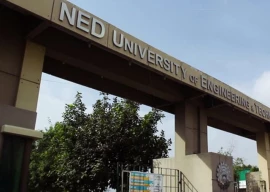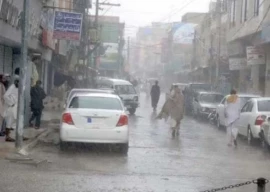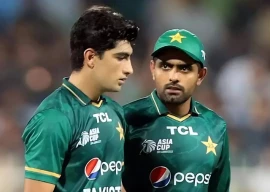
“After six years, I am showing my stuff here in Karachi,” she said at the opening on Thursday. “I am very nervous to show here because of the very knowledgeable audience in Karachi.”
She shared her main motivations into the latest works. “I really wanted to show people how differently we grew up in contrast to a gentry-based division that there is now. [Sadly] there is no coming together of the people in the common spaces — be it the beach or the cinema houses.”
Bani Abidi returns with the ghost of Mohammad bin Qasim
This time, Abidi has put together a collection of works with a common theme: Karachi. How is the city seen, how is it felt about, how does one thrive in it and what are the nature of one’s feelings about a city many call home - these are some areas unearthed by the artist in her solo exhibition. Titled ‘Look At The City From Here — the most amount of people standing still, screaming and laughing’, the works curated by Hajra Karrar Haider are on display at Gandhara art space till August 8.

The Ghost of Mohammad Bin Qasim. PHOTOS: AYESHA MIR/EXPRESS
The works are a collection of work done by Abidi between 2006 and 2016 including a video installation titled ‘Funland — Karachi Series 2’.
“It’s all about the city,” said Abidi. She was referring to six video installations on how public spaces are much more divided than ever before. “For some residents of the city, these same spaces are dirty and threatening while for others it a prohibitive place to go. But what I really want to tell you is that public spaces in Karachi are not shared spaces, at all!”
How Khaula Jamil turned her love for Karachi into photo blog
True to the core
Abidi has also taken photographs or “rather portraits of those few who take over the city streets, once these get emptied”. She is certainly documenting some perilous thought-process, which she wanted to stress on.
Her collection named ‘And they died laughing’ shows people in their final laughing moments. “In these portraits, there is a pun intended to die laughing, I am playing with the pun,” she explained.
But it is here, in the city alone she narrated, “there is a strong sense of self, where you exist in the city, for a host number of reasons — there is the middle class, which sees through the public spaces that are considered by some to be unsafe spaces to gather, yet for others the poor lot it’s an expensive medium to feel.”
The six installations portrayed images from Funland and Nishat Cinema to the Theosophical Society and the Clifton beach.

And They Died Laughing.
When you talk of the city, you cannot forget to discuss the barriers of all kinds on the roads. Abidi painted a variety of them in her collections titled ‘Flailing Barriers’. “[There are] barriers of all kinds, moving ones though. No one has got control over them,” she said.
Reading on Karachi
Later at the opening, Zambeel Dramatic Readings presented the work of Asad Mohammad Khan’s essay titled ‘Toofan Kay Markaz Mein’. It delved into old Karachi of the decade of the 1950’s. Two performers, Fawad Khan and Meesam Naqvi, portrayed a picture of old Saddar area, “which was if not all … then to a great degree a different space altogether”.
Of the landmarks they mentioned, there are only a few hallmarks left now, such as the Thomas and Thomas book store, the Singer machine showroom.
Published in The Express Tribune, July 16th, 2016.























COMMENTS
Comments are moderated and generally will be posted if they are on-topic and not abusive.
For more information, please see our Comments FAQ